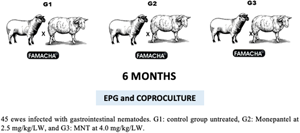Published online by Cambridge University Press: 16 February 2022

Gastrointestinal parasite control has been a major challenge to livestock due to the failure of anthelmintic treatments. Monepantel (MNT) was introduced in 2009 as an alternative treatment option showing a new mechanism of action against nematode parasites. To study the response of MNT in a suppressive regime, 45-Suffolk and White Dorper naturally infected sheep were divided into one of three groups, G1: control – with no treatment, G2: MNT at 2.5 mg kg−1 live weight (LW) PO every 30 days, and G3: MNT at 4.0 mg kgLW−1 PO every 30 days for 6 months. Every 15 days, the animals were individually weighed (body weight, BW) and checked for Famacha (FMC) and body condition score (BCS). The efficacy of MNT was evaluated weekly by fecal egg count (FEC) every month. FEC showed >97% efficacy at the start of the experiment, revealing a significant reduction for G2 (28%) and G3 (39%) in the following months. There was no treatment, BW or BCS effect between treatments; however, there was a period (P < 0.0001) and a treatment vs period interaction (P < 0.0001) for BW. The data revealed that MNT at a therapeutic and suppressive dose had a non-linear polynomial efficacy regression (R2) of 0.988 and 0.992, respectively. This original experiment demonstrates how short-interval and suppressive MNT treatments would rapidly select Haemonchus contortus, showing a fast susceptible-resistance phenotypic population replacement. Therefore, it is suggested that MNT might be carefully used in parasite control programmes alongside other management strategies (i.e. FMC, BCS) to reduce treatment frequency and the selection process for resistance.